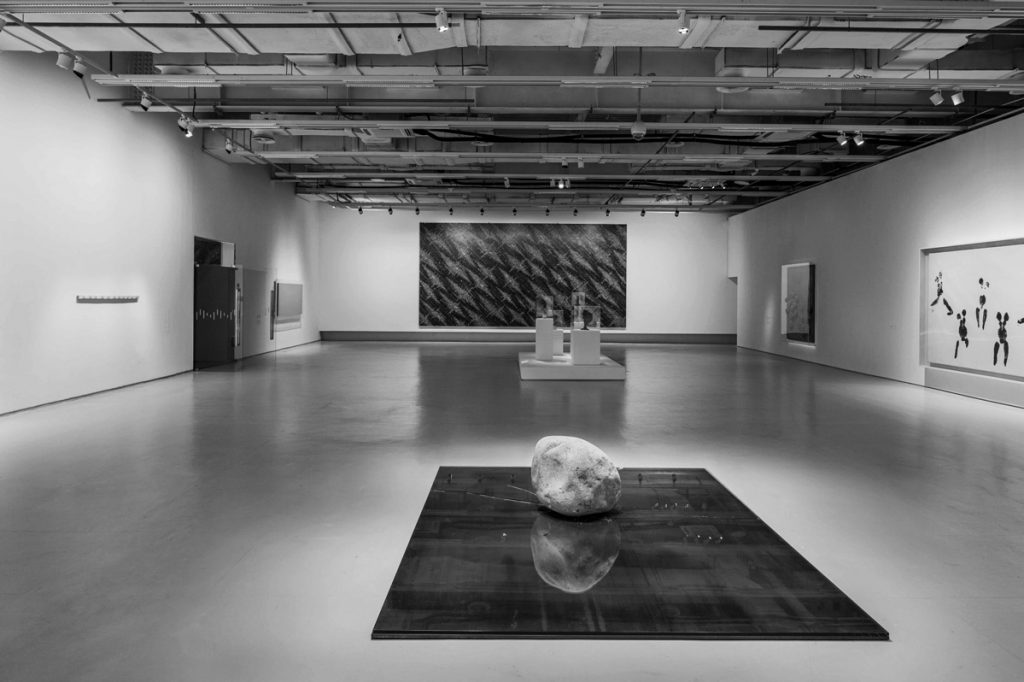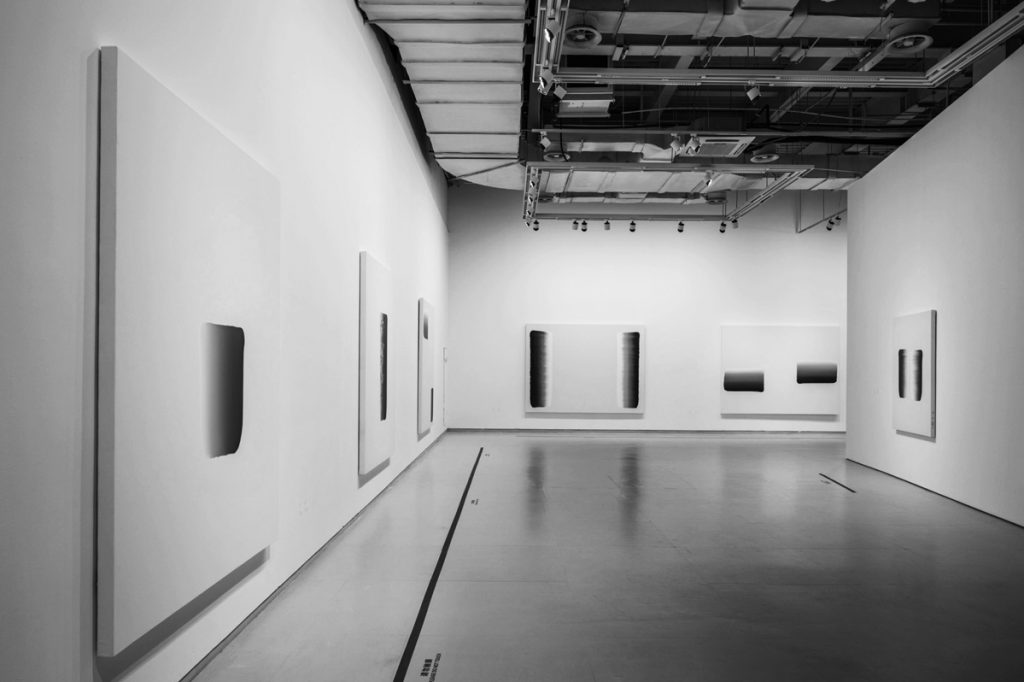The Dilemma of the Avant-Garde and its Display
The Challenging Souls: Yves Klein,
Lee Ufan, Ding Yi
Power Station of Art, Shanghaik
28.04.19 – 28.07.19
Translated by Duncan Hewitt
First of all, it’s Relationship, constructed out of steel plates and raw stone, and Dialogue, painted in silver, which raise the curtain. Next is Endless Staircase, which ascends to the second floor in a cluster of milky white and ultramarine gravel. Then, a pool full of waves of blue pigment surges up from the epoxy resin floor. Further away, there is also the latest instalment of the Appearance of Crosses series of paintings, made up of a coloured grid. At this moment, if you turn your head slightly to one side, the foreword on the wall – not an overly urgent introduction, but one that cannot be ignored – cuts across your line of vision.
As the title suggests, this exhibition establishes a fresh connection between three artists who have been active in different periods and places: Yves Klein, Lee Ufan and Ding Yi. The basis for the selection of the artists is revealed by the rather empty-sounding phrase, ‘The Challenging Souls’. This rather vague choice of title was really for want of a better alternative – it stems from the ambiguity in the exhibition’s own core concept. In the foreword, the curators directly invoke the term ‘avant-garde’. But when three artists from very different historical circumstances are integrated into a concept that is complicated, owing to long-term social changes, perhaps it is only by returning to the most fundamental characteristics that you can find the links that connect them. And it’s precisely these special characteristics that most require contemplation. Among sceptical voices, similar questions have repeatedly been raised: looking at the works of the three artists, what is actually meant by ‘challenging’? How can we challenge? What should we challenge? – And is it effective?

The Challenging Souls: Yves Klein, Lee Ufan, Ding Yi. Installation view, Power Station of Art, Shanghai.“挑战的灵魂:伊夫·克莱因、李禹焕、丁乙”展览现场图,图片来源于上海当代艺术博物馆。
Before explaining further, it is necessary to elucidate the relationship between these three examples and avant-garde art. What they represent is the revival and reincarnation of several successive waves of the avant-garde in Western Europe, Japan, South Korea and China, from post-war to the present. In different contexts, these have variously been labelled as New Realism, Mono-ha, the Monochrome Painting Movement, and the ’85 New Wave. In comparison with the wide range of narratives of the avant-garde, what the Power Station of Art ( PSA ) offers is hardly the most comprehensive and original explanation, but a version that is targeted in its selection of participants, and even-handed in its attitude. It suggests that – at a point when the notion of the avant-garde is becoming more inflexible by the day, due to its integration into the aesthetic system and the art market – we still have a chance, through reidentifying, rearranging and redisplaying scattered yet classic examples of the phenomenon, to grasp a fresh source of creative energy from the progressive and transformative aspects of this fractured concept.
As to which aspects of the exhibition are worth reflecting on, they obviously do not lie in the repetition of the ‘avant-garde equals challenge’ equation, but in the methods it employs, and the dilemma it exposes when it demonstrates this proposition. In terms of the aims of the exhibition, the PSA has taken on two tasks: firstly, to open up a relatively independent space for each work of art, and invite viewers into this space, and ensure that the avant-garde’s relaxation in terms of cooperating with the mainstream aesthetic system will continue to be possible; secondly, to embed the work in the institutional space of the art gallery, so that its meaning is refreshed and revealed in a new context. In practice, however, from the tourists who surge into the gallery, to highly educated critics, everyone shares a certain awkward experience. On the one hand, the avant-garde is stripped of its historical depth and loses its own focus. On the other, the display’s rejection of the tree and branch structure, and its emphasis on a linear logic, has not only failed to produce an inspiring approach, it even indirectly undermines the historical credibility of the avant-garde.
Hall 4, on the second floor of the PSA, is the site of the most concentrated interaction between the three artists in this exhibition. Works installed in its various corners include: Ding Yi’s Appearance of Crosses, the result of his hard, repetitive labour; Lee Ufan’s Relationship, which explores a dialogue between nature and man-made objects, and his attempt to penetrate painting’s basic language in his From Point/From Line; Yves Klein’s monochromes and sponge sculptures, which use a single colour as the main visual characteristic – and there’s also ‘measurement of the body’, which he achieves by making moulds of the human body. The curators’ conception was that, by removing knowledge, this hall should be a ‘smooth’ space for releasing the artworks’ latent aesthetic energy, and that this would complement the more textured space, which focuses on an ordering of history. The latter, which is the annotated section of the exhibition, is located in the adjacent Hall 2, where Klein’s creative career is portrayed on a year-by-year basis, and the middle hall, where Ding Yi’s manuscripts and performance art materials are arranged in chronological order. The result, however, is that the works in this hall are thus weakened into rootless visual forms. They can only float like phantoms, cut off from any narrative.
At the same time, with hindsight, these works inevitably remind us of similar images, those classics of earlier or the same generations so often cited by critics as references, such as Rodchenko’s monochrome paintings or Mondrian’s grids. There is another variation on this problem in Hall 5, next door. When four or five of Ding Yi’s Appearance of Crosses series, made up of countless + and × symbols, and seven or eight of Lee Ufan’s Dialogues, which feature brushstrokes changing gradually from cold to warm, are condensed onto the same surface, the uniqueness and necessity of both are called into question.
Overall, the exhibition nonetheless does create a scene with a certain sense of order. This includes the introduction ( the large-scale works in the entrance hall ), the bedding-in ( Hall 2 and the literature in the middle hall ), the intersection ( the crossover in terms of time and space in Hall 4 ) and reinforcement ( variations on the same series in Hall 5 ). However, the exhibition does not fully explain the last two sections, especially the third section, which are particularly important in terms of the logic of the display. Surely, the so-called avant-garde is not destined to become merely a series of random repetitions and copies?
The current situation leads us to Peter Bürger’s assertion that avant-garde art of the 1950s and 60s was merely an inferior example of the pioneers of the 1910s and 20s, because the latter’s challenge to the system had already been re-institutionalised by the former as the art of self-discipline.1 If we slightly extrapolate from this viewpoint, we arrive at a common criticism of this exhibition: with the consolidation of the established paradigm, the work of the three artists gradually becomes detached from the reality of life, and lacks an aesthetically contemplative cultural landscape, and the exhibition encourages the development of this type of situation. There is no lack of insight in this judgement, but it is obviously unfair and ignores the transfer of subject matter that the artists quietly achieve while reproducing the techniques and methods of their predecessors.
For example, Benjamin Buchloh believes that Klein overturned Rodchenko’s criticism of the myth of bourgeois art and restored the artistic aura of the declining culture industry;2 and he also ignored differences in detail in similar cases in similar historical periods. As an example, Lee Ufan himself said that Arte Povera eventually moved towards metaphysics, while Mono-ha developed a new space science by exploring the relationship between objects.3 He also forgets that repetition can also generate strength and difference; for example, Hou Hanru points out that Ding Yi’s fascination with drawing creates inner tranquillity and an open system of continuous dissolution and reorganisation.4
Regarding repetition in the avant-garde, Hal Foster’s interpretative model is even more persuasive: as a traumatic event of the era, avant-garde art’s meaning can only be retrospectively clarified through repeated patching up of a constantly recurring symbolic wound.5 Therefore, the failure of the exhibition is not that it does not reveal the repetition often seen in avant-garde art – rather that it fails to select the subjects of the exhibition more carefully, nor does it organise a control group. In fact, the reconstructed relationship revealed in the specific aspect-oriented repetition ( which can be vertical, horizontal or internal ) outlines the inner constraints of the art system – the evolution of power. Of course, the curators also surreptitiously lay clues connecting the three artists: for example, they all lived in a period of transition in their respective societies, and stretched the comparative horizons of things. But these clues stop at the external framework and fail to fully penetrate the problematic history contained in the texture of the work.
Returning to the questions posed in the first section, how should we actually regard the challenges for the avant-garde? An indirect reply is: If we believe that, similarly to avant-garde art itself, the ( re )writing of avant-garde art – display in a gallery being the most direct and traditional form of this – is also the action that reactivates the fossilised aesthetic system, then it can be said that the symptoms the exhibition displays also hint at the avant-garde’s dilemma. That’s to say, it is not at all easy to clear an established, and yet incomplete, path in the midst of such disorderly historical practice. In this sense, while the PSA exhibition has not fulfilled its ambitions and promises, it can still be seen as a commendable attempt. Particularly today, at a time when upheavals in the system have thrown the future into confusion, and the cutting edge of avant-garde has lost its focus, this attempt has rekindled our vision of the challenges.
1. Peter Bürger, Theory of the Avant-Garde ( 1974 ), trans. Michael Shaw ( Manchester and Minneapolis: Manchester University Press and University of Minnesota Press ), 1984.
2. Benjamin H. D. Buchloh, ‘The Primary Colors for the Second Time: A Paradigm Repetition of the Neo-Avant-Garde’, October, 37 ( Summer 1986 ), pp. 41–52.
3. Lee Ufan, ‘Mono-ha: Foreshadowing and Prophecy 1977–2001’.
4. Hou Hanru, ‘An Excessive Minimalist’, in Rong Bao Zhai, 2010, vol. 4, pp. 208-9.
5. Hal Foster, The Return of the Real: The Avant-Garde at the End of the Century ( Cambridge MA and London: The MIT Press ), 1996.
前卫的困境及其展示 ——
“挑战的灵魂:伊夫·克莱因、李禹焕、丁乙” 观展札记
挑战的灵魂:伊夫客克莱因、李禹焕、丁乙
上海当代艺术博物馆,上海
2019年4月28日-2019年7月28日
首先,是钢板与原石建构的一组《关系项》(Relatum)和银色颜料粉刷的一场《对话》(Dialogue)揭开了序幕;接着,在铺排于两侧的乳白与群青色碎石的簇拥下,一条《无尽的阶梯》(Infinity Stairs)向二楼攀升;然后,满池的《蓝色色粉》(Dry Blue Pigment)汇聚成的色浪,有力地从环氧地坪上涌起;在更远处,还醒目地悬挂着以彩色网格为显著标志的系列画作《十示》的新近发展。此刻,如若稍稍侧转过头,墙体上的展览前言将作为一段并不过度急切、但却不可忽视的说明插入观众的视线。如其标题所示,本次展览是对三位活跃于不同时期与地域的艺术家——伊夫客克莱因、李禹焕和丁乙——的重新勾连;人员遴选的根据则由一个语意稍显空泛的词组——“挑战的灵魂”——和盘托出。这一模糊的命名实属无奈,它源自展览的核心概念自身的含混。在前言里,策展人明确呼唤了“前卫”之名。但当三位历史境遇相殊的艺术家被统合于一个因长期流变而盘根错节的概念时,或许只能折返回其最基础的特质,以寻求彼此的铆合点,而这重特质恰恰是最需要反思的。譬如,诸多质疑的声音里,类似的问题被反复提及:纵观三位艺术家的作品,究竟何谓挑战,如何挑战,挑战什么,又是否有效?
进一步阐释之前,有必要厘清三个样本与“前卫”的关系:事实上,他们代表的是从战后到当下依次在西欧、日韩和中国发生的数波前卫艺术的回魂与转生,不同语境之下,曾被分别冠以新现实主义、物派、单色画运动和“85新潮”之名。因此,相较“前卫”的种种叙事,上海当代艺术博物馆提供的绝非最全面、深刻或独到的讲解,而是一个在对象上经过拣选、在立场上力求公允的版本。它暗示的是,在“前卫”因美学体制与艺术市场的收编而日趋僵化之际,通过对散落各处的典范案例的再次辨识、编排和展陈,我们有望从该概念的断裂、跨越和转化地带攫取它所内蕴的生新活力。如果说展览确有需要审思之处,显然不是重提了“前卫即挑战”的等式,而是它论证这一命题时采取的方案与暴露的困局。就展览意图而言,策展机构在此承载了双重职能:其一,是为每件作品爆破出相对独立的界域,或者说,是将观众邀入作品的初始场景,确保它对美学体制的松动依然可能;其二,则是将作品嵌入美术馆这一制度性空间,使其意义在新的脉络内得以界定、翻新和澄明。然而,悖逆的是,从贸然闯入的游客到训练有素的批评者,都分享了某种尴尬的体验:一方面,当前卫艺术被从历史的景深中剥离,它也丧失了自己的针对性;另一方面,反树状结构和线性逻辑的陈列非但没能生成具有启发意义的系谱,甚至还间接贬损着前卫艺术的历史信誉。


The Challenging Souls: Yves Klein, Lee Ufan, Ding Yi. Installation view, Power Station of Art, Shanghai.“挑战的灵魂:伊夫·克莱因、李禹焕、丁乙”展览现场图,图片来源于上海当代艺术博物馆。
在博物馆二层的4号展厅,也是本次展览中三位艺术家的交互最密集之处,下述作品被安插于不同角落:丁乙以艰辛的重复劳作完成的《十示》;李禹焕探讨自然存在与人造物之对话的“关系项”雕塑,以及他从《从点开始》(From Point)、《从线开始》(From Line)深入绘画基本语言的尝试;伊夫客克莱因用单种颜料在载体上涂就的《单色画》(Monochrome)和《海绵雕塑》(Sponge Sculpture),还有他将模特的肉身拓印于画布而得的《人体测量》(Anthropometry)……在策展人的规划中,这一展厅应是通过去知识化来释放艺术品美学潜能的平滑空间,它与侧重历史爬梳的纹理空间互为补充——后者作为展览的注释性部分,被放置在了临近的2号展厅(以年谱形式呈现克莱因的创作生涯及相关资料)与中庭(按照时间顺序编排丁乙的手稿,还补充了他早期行为表演的资料)。然而实际结果是,这些作品却因此被削弱为纯粹的视觉形式,只能以幽灵般的状态悬浮着。更糟糕之处在于,借着后见之明,我们无法全然回避这些作品唤醒的近似形象,例如罗德琴科的单色画、佩罗尼的树木雕塑、蒙德里安的网格等等常被批评家们引为三者参照物的前代或同代经典。在隔壁的5号展厅,还存在问题的又一变体,当丁乙的四五件由无数“+”和“×”号组成的《十示》,李禹焕的七八张由冷色和暖色渐变笔触构成的“对话”被压缩在同一平面,彼此的特殊性和必要性也经受着拷问。整体而言,展览固然构筑了一个颇具秩序感的图景,其中有导入(一层大厅和二层平台的大体量作品),有铺垫(2号展厅和中庭的文献),有交织(4号展厅的跨时空组合),也有强化(5号展厅的同系列变奏);但是,对于在展示逻辑上至关重要的后两个部分,尤其是第三部分,展览却没有做出充分的释读。难道所谓的前卫注定只是艺术中偶然的反复?
面前的情形很容易将我们引向彼得客比格尔(Peter Burger)的论调:1950—1960年代的前卫艺术不过是对1910—1920年代的前卫运动的拙劣效仿,因为前者将后者对体制的挑战再制度化为了一种自律的艺术。1此观点稍加延伸,则会推导出关于本次展览的常见指摘:克莱因、李禹焕和丁乙的创作,伴随他们对既定范式的巩固,某种程度上已沦为与生活实践脱节且缺乏美学自省的文化景观,而本次展览无疑又推动着这种景观化的进程。该判断不乏洞见,但显然有失公正,它既忽略了艺术家重复前人技法时悄然完成的议题转移,比如本雅明客布洛赫(Benjamin Buchloh)就认为,克莱因实际将罗德琴科从反资产阶级立场就艺术神话所作的批判翻转成了对文化工业中日益减损的艺术灵晕的恢复;2也无视他们与相同历史截面上近似案例的细部差异,比如根据李禹焕的自述,贫穷艺术最终走向了形而上学,而他从属的物派则在摸索物物关系的过程中发展出新的空间科学;3还忘记了重复也可能是对强度的要求和对差异的生产,比如侯瀚如曾指出,丁乙着魔般的描画同时创造了内在的宁静和不断分解重组的开放系统。4有关前卫艺术中的重复,更具说服力的或是哈尔客福斯特(Hal Foster)的阐释模型:作为其时代的创伤性事件,前卫艺术的意义唯有在它的不断回归所带来的对象征界伤口的反复缝合之中才能被回溯性地澄明。5因此,展览的不足并非暴露了前卫艺术里常见的重复,而在于没能更审慎地拣选展览对象和组织对照组,从而呈现在特定面向的重复(可以是纵向的,也可以是横向的,还可以是个体内部的重复)中被不断重构的关系,并且勾勒出艺术体制内在的“压抑—动力”的演化。当然,必须承认,策展人也暗中设置了串联三位艺术家的线索,譬如他们都身处各自社会的转轨期,他们拉伸出了东西比较的视角等等,但这些线索更多地止步于外部性的框架,未能充分深入作品肌理所蕴含的问题史。
回到首段的设问,究竟该如何看待前卫的挑战性?一个迂回的答复是:如果我们相信,与前卫艺术本身类似,对前卫艺术的书写和再书写——美术馆的展示是其最直观和传统的形式——也是激活石化的美学体制的行动;那么可以说,展览的症候也暗示了前卫的窘境,亦即,从纷乱的历史实践中梳理一条成立且未竟的道路绝非易事。在此意义上,上海当代博物馆的展览虽然未曾兑现它的抱负与承诺,但仍不失为值得赞许的尝试,尤其在体制的激变搅乱了前景而前卫的锋芒失去了焦点的今日,这样的尝试本身就重燃了我们对挑战的想象。